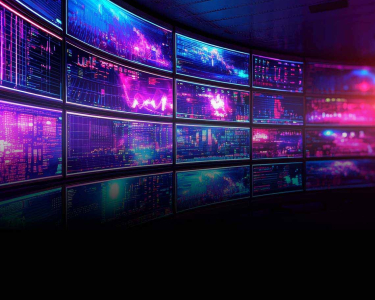Green CodeRefiner™: Making Every Line of Code Count for Sustainability
The global shift toward sustainability is not just reshaping industries like manufacturing or transportation; it is transforming technology, too. Every click, swipe, and stream consume more energy than we realize. While we celebrate the convenience and innovation technology brings, the environmental cost of inefficient software is hard to overlook.
There are billions of computing devices, many of them operating 24X7. This, combined with the growing energy consumption of servers, makes information and communication technologies a significant contributor to global emissions. Software powers all computing devices and ultimately determines their energy efficiency. Consequently, modern software must minimize the energy consumption of devices. This is where green coding steps in - a smarter, more sustainable approach to developing software that performs and does so responsibly.
The Digital Dilemma: Why Green Coding Matters
Behind every seamless app experience or blazing-fast website is a mountain of code that fuels data centers, cloud infrastructures, and personal devices. These systems consume vast amounts of energy. Data centers alone, the backbone of digital infrastructure, account for approximately 1% of the world’s electricity use, and this figure is projected to rise dramatically. Moreover, the Information and Communications Technology (ICT) sector is responsible for an estimated 1.4% of global greenhouse gas (GHG) emissions.
Amidst these challenges, green coding emerges as a vital practice for software developers aiming to reduce the environmental footprint of their applications. Developers can contribute to sustainability efforts by adopting energy-efficient coding practices without compromising performance or functionality.
What is Green Coding?
At its core, green coding refers to the practice of developing software that minimizes energy usage and optimizes computational resources. Unlike traditional coding, which often prioritizes functionality and speed, green coding emphasizes environmental responsibility along with technical efficiency.
The key goals of green coding include:
- Energy Efficiency: Reducing the energy consumed during computation.
- Hardware Optimization: Ensuring software performs efficiently across devices.
- Longevity and Maintenance: Building software that lasts longer with minimal updates.
- Carbon Footprint Reduction: Lowering GHG emissions linked to software use.
It incorporates sustainable practices across the Software Development Lifecycle (SDLC), including:
- Using efficient algorithms to reduce processing demands.
- Minimizing data to lower storage and transfer needs.
- Designing energy-conscious architecture, such as serverless architecture and edge computing.
By addressing the inefficiencies in algorithms, data handling, and resource utilization, green coding ensures that every line of code contributes to sustainability.
For example, consider a video streaming platform. Traditional approaches may always prioritize high-definition video, which consumes massive server space and bandwidth. A green coding alternative might include adaptive streaming - delivering optimal quality based on the user’s device and connection speed. This reduces unnecessary energy consumption while maintaining user satisfaction.
How Green Coding Works?
Green coding focuses on designing and implementing software to reduce energy consumption at every stage. It works through:
- Efficient Algorithm Design: Algorithms drive software performance, and their efficiency directly impacts energy usage. For example, Choosing an O(nlogn) sorting algorithm over an O(n2) can save significant processing power for large datasets. Optimizing loops and recursive calls also avoid unnecessary computation.
- Resource-Conscious Data Handling: Using caching and compression techniques, minimizing data transfers between servers and clients. It avoids over-fetching in APIs by requesting only the required fields.
- Memory and Storage Optimization: Inefficient memory usage leads to frequent swapping between RAM and disk storage, increasing energy consumption. Green coding focuses on:
- Avoiding memory leaks.
- Using lazy loading where data or resources are only loaded when required.
- Reducing the use of global variables which can result in prolonged memory retention.
- Energy-Aware Compilation: Compiles code with energy-efficient settings. For example, many compilers offer optimization flags (e.g., -02 or -0s in GCC) that reduce binary size and energy consumption.
- Testing for Efficiency: Incorporates energy profiling tools into the development pipeline to measure power consumption.
Why Does Green Coding Matter?
The answer lies in impact scaling. A single inefficient algorithm running on millions of devices can result in massive energy waste. Conversely, a small optimization such as reducing server-side processing time by 10% can significantly reduce global power consumption. Furthermore, adopting green coding practices benefits businesses directly by:
- Cutting Costs: Optimized software reduces server loads, saving on operational expenses.
- Enhancing Performance: Energy-efficient code is often faster and more responsive.
- Meeting Sustainability Goals: Many organizations now aim to meet carbon neutrality targets - green coding aligns development efforts with these.
Introducing Tech Mahindra’s Green CodeRefiner™
Digital transformation now includes a new paradigm shift: sustainable transformation. Customers often invest significant resources in application modernization to leverage modern platforms and cloud technology. This is where tools like Green CodeRefiner™ (GCR™) come into play.
Developed in partnership with Microsoft, GCR™ modernizes your code to make it energy efficient. On this, you can easily incorporate modern technologies and architecture use cases without any additional sustainability cost. Before implementing advanced use cases like generative AI or enhanced platforms, your application modernization process becomes inherently sustainable when you convert your existing code using GCR™.
Instead of modernizing code snippets piecemeal, we recommend adopting a comprehensive approach, converting the entire project code into green code as the first modernization step. GCR™ guarantees a 30–40% improvement in efficiency, ensuring functional equivalence across the entire converted project.
Here are the key features of GCR™:
- Code Optimization for Energy Efficiency: Leverages AI-driven green prompts to analyze and refactor code for optimal energy efficiency. It evaluates carbon emissions of existing code, converts existing code to green code, and helps implement sustainable coding practices across various 20+ programming languages, including Python, Java, C++, and C#.
- Automated Unit Test Generation and Customizable CI/CD Integration: Automates unit test creation to ensure robust code quality. Our Green IT consulting services integrate these tests seamlessly into CI/CD release pipelines, whether it is Jenkins or Microsoft Azure DevOps, without disrupting workflows.
- Emissions Tracking and Analysis: Offers comprehensive emissions tracking for both system and codebase. Using the recommended libraries, it provides detailed emissions reports before and after code optimization, highlighting the environmental impact of development activities.
- Dynamic Reporting and Recommendations: Generates dynamic data-driven reports with visual graphs and actionable recommendations, helping clients track emissions trends and plan for further improvements in the development process.
- Data Privacy Assurance: complies with Microsoft Azure’s stringent data privacy standards, ensuring no personal data is utilized during the code refinement. This guarantees the highest level of confidentiality and builds trust with our clients.
Benefits beyond Sustainability: Quantifying the Impact
The business benefits of GCR™ extend beyond sustainability goals with measurable ROI such as:
- 20–40% Improved green impact score.
- Reduced Scope 2–2 GHG emissions.
- Enhanced developer productivity.
- Seamless integration with existing DevOps workflows.
- Improved energy efficiency of application source code.
How to Get Started with GCR™
Start your sustainable transformation journey by incorporating GCR™ into your CI/CD release process. Access GCR™ through the Microsoft Azure Marketplace and explore its features.
Choose from our trial, pro, or enterprise plans, and let our experts help you embed green IT practices. The journey to sustainability begins with small, well-intended steps. Green coding is one such step - a powerful way to balance innovation with responsibility.
References
- International Energy Agency (IEA). (Oct 2024). What the data centre and AI boom could mean for the energy sector. IEA.org
- Ericsson. (n.d). Exponential data growth – constant ICT footprints. Ericsson.com
- Microsoft Azure Marketplace. (n.d). Green CodeRefiner and Green IT Consulting Services. Azuremarketplace.microsoft.com
With over 10 years of diverse experience in ESG consulting and research, Priyanka specializes in reporting and disclosures across various sectors. Understanding the intricacies involved in reporting, Priyanka ensures regulatory compliance requirements and has been working in a role of improving ESG communication to meet the needs of various stakeholders. She also has a background in providing training and education on ESG and sustainability.








